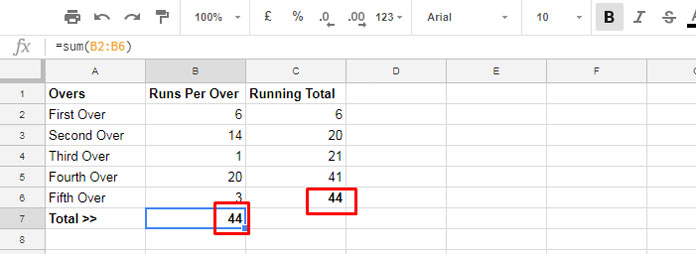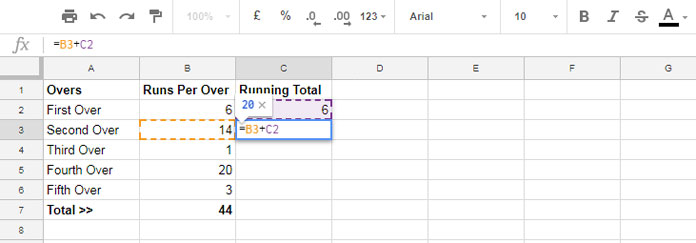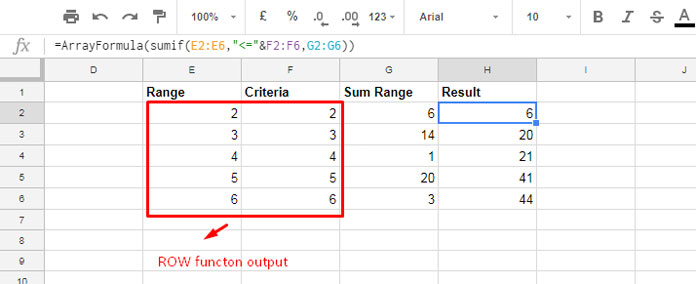To write cumulative sum, aka running total array formula in Google Sheets, we can use functions such as SUMIF, DSUM, MMULT, and SCAN (LHF). In this tutorial, I’ve included formulas based on all of them.
I’ve extensively used such calculations to plot S Curves as part of generating daily Progress Reports (DPR) related to my job.
Here I am providing you with six different formulas to do cumulative sum (CUSUM) in Google Sheets.
In this tutorial, you will get two non-array and four array-based running total formulas to use in Google Sheets.
In real life, there are several instances where we can use a cumulative sum. We can consider a Cricket match score as an example.
In a Cricket match, the total score is the summation of the Runs.
Each time a player scores runs, it is added to the total.
Column C in the below screenshot is an example of a CUSUM in a Cricket match.

If you are not familiar with the Cricket game, you can ignore everything except the numbers in the above sample data.
You only need to understand that the sum of B2:B6 (B7) is equal to the value in C6, which is derived from the summation of a sequence of runs/numbers in B2:B6.
Here column C contains the running total of the numbers in column B.
Normal Running Total (Cumulative Sum) Formulas in Google Sheets
1. Using the Addition Operator
Here is the basic or the simplest form of running the total calculation in Google Sheets.
Steps:
- In cell C2 insert
=B2. - In cell C3, insert the formula shown in the image, i.e.,
=B3+C2, and drag it down.
Your CUSUM is ready.

2. Using the SUM Function
Here is another similar approach to getting the CUSUM in Google Sheets.
This is a tricky use of the SUM function.
You can use the below formula directly in cell C2 and then drag it to the rows down.
=sum($B$2:B2)Here, the use of the dollar symbol makes the first part of the referenced cell absolute. The second part is relative.
After copying this formula down, check the formula in cell C3. It would be as follows.
=sum($B$2:B3)I hope it makes sense.
Now let us see how to code running total array formulas in Google Sheets.
Array-Based Running Total Formulas in Google Sheets
As I have mentioned, we can use different functions here, such as SUMIF, MMULT, DSUM, and SCAN.
Among the four, SUMIF is the popular choice of many Google Sheets users and SCAN is the latest in the foray.
1. Cumulative Sum Array Formula Using SUMIF
A one-line array formula can return CUSUM in Google Sheets.
You only need to key the below formula in cell C2 (empty C2:C first).
=ArrayFormula(If(len(B2:B),(SUMIF(ROW(B2:B),"<="&ROW(B2:B),B2:B)),))Formula Explanation:
The core part of the above CUSUM formula is the SUMIF function.
Syntax: SUMIF(range, criterion, [sum_range])
First, let’s see the role of the ROW function, which acts as the range and criterion within the SUMIF here.
In the following example, the range is E2:E6, the criterion is “<=”&F2:F6, and the sum_rage is G2:G6.

The running total array formula in cell H2 uses these values and returns the cumulative sum.
Logic:
For example, in cell E4 (range), the value is 4. The formula checks whether this value is <= the value in F2:F6 (criterion).
It evaluates to TRUE in the range/array F2:F4, so the SUMIF totals column G up to that range and returns 21 in H4.
2. Cumulative Sum Array Formula Using MMULT
We can use MMULT for writing a cumulative sum array formula in Google Sheets.
As per the above example, we can use the following MMULT formula for returning CUSUM in Google Sheets.
=ArrayFormula(MMULT(IF(ROW(B2:B6)>=TRANSPOSE(ROW(B2:B6))=TRUE,1,0),B2:B6))For the formula explanation, please check my guide – Running Total Array Formula in Excel [Formula Options].
Here in Google Sheets, I have additionally used the ArrayFormula function together with MMULT.
But when using its competitor application, you may enter the formula using Ctrl+Shift+Enter (legacy array method), or if you are using Office 365, it may spill the result by default.
In Google Sheets, we can use an open range starting from any row in formulas.
So, you may want to make B2:B6 open.
In that case, you can use the below MMULT-based running total array formula in Google Sheets.
=ArrayFormula(if(len(B2:B),MMULT(IF(ROW(B2:B)>=TRANSPOSE(ROW(B2:B))=TRUE,1,0),n(B2:B)),))It might be resource hungry. So I don’t recommend using it.
3. Running Total Array Formula Using DSUM
The DSUM function is another option to code a running total array formula in Google Sheets. It’s a database function.
So we should format the numbers in the range B2:B6 to 1-12-123-1234 pattern within DSUM. It turns out to be the database for calculation.
We have followed similar approaches earlier using functions such as DMIN and DMAX (please refer to “Related Topics” 9 and 10 below).
I am copying the same formula used there. The only difference is the function in use and cell range (array) reference.
=ArrayFormula(DSUM(transpose({B2:B6,if(sequence(5,5)^0+sequence(1,5,row(B2)-1)<=row(B2:B6),transpose(B2:B6))}),sequence(rows(B2:B6),1),{if(,,);if(,,)}))Here also you can make the cell range B2:B6 open. You can find the details within those two tutorials.
4. Running Total Array Formula Using SCAN (LHF)
SCAN is a new entrant into the foray of cumulative sum array formulas in Google Sheets.
It’s a LAMBDA helper function (LHF), the simplest way to code an array formula to return the running total in Google Sheets.
For a closed range, the below code will do the magic!
=scan(0,B2:B6,lambda(a,v,(a+v)))When you want to open B2:B6 to B2:B, use it as follows.
=ArrayFormula(if(B2:B="",,scan(0,B2:B,lambda(a,v,(a+v)))))That’s all about CUSUM formulas in Google Sheets. Thanks for the stay. Enjoy!
Thanks for the stay. Enjoy!
Related Topics:-
- Array Formula for Conditional Running Total in Google Sheets.
- Reverse Running Total in Google Sheets (Array Formula).
- How to Calculate Running Balance in Google Sheets.
- Cumulative Balance against Each Payment in Google Sheets.
- Running Count of Multiple Values in a List in Google Sheets.
- Running Count in Google Sheets – Formula Examples.
- Cumulative Count of Distinct Values in Google Sheets (How-To).
- Reverse Running Count Simplified in Google Sheets.
- Running Max Values in Google Sheets (Array Formula Included).
- Find the Running Minimum Value in Google Sheets.






















Hello, your running total array formula worked for me:
=ArrayFormula(If(len(B2:B),(SUMIF(ROW(B2:B),"<="&ROW(B2:B),B2:B)),))How can I amend this to check a date column and begin a new running total with each new year?
Hi, The Jay Jetson,
Have you checked the first tutorial under the related topic section below the post?
That’s a resource-hungry formula and may slow down your sheet in case you have a large set of data in it.
I have an alternative formula that involves a helper column. If you are interested, please let me know and share a sample sheet (leave the URL in your reply).
Hi, The Jay Jetson,
Please check my new tutorial here – Reset Running Total at Every Year Change in Google Sheets (SUMIF Based)
I have an improvement on SUMIF.
You don’t need to wrap it in an IF statement, if in the criterion you enter a SEQUENCE. Your example would look like this:
=ArrayFormula( SUMIF( ROW(B2:B), "<="& SEQUENCE(COUNT(B2:B),1,2), B2:B) )Hi, Giovanni Cipriani,
Imagine the range is B2:B10 and B5 is empty. Try your formula. It won’t work correctly.
Hello! Apologies if I’ve missed it, is there a way to add a bunch of video runtimes? For example, here is an excerpt of some runtime data in hours/minutes/seconds/milliseconds.
00:00:02:04
00:00:02:05
00:00:01:14
00:00:01:12
00:00:06:00
If I am to summarize the duration of all the videos added together, is there a formula for that? Thank you in advance.
Hi, Laura,
It seems the format is not correct. You may want to replace the last colon with a period.
Then you can sum it.
You can use Regex to Replace the Last Occurrence of a Character in Google Sheets.
If the above data is in B2:B6, you can try this formula.
=text(ArrayFormula(sum(value(REGEXREPLACE(B2:B6,"(.*)\:","$1.")))),"hh:mm:ss.000")Hi there! I would like to implement an auto-expanding running balance, but add one criterion. The problem is that SUMIF doesn’t allow me to do that, and SUMIFS doesn’t auto-expand. Is there a good solution?
Hi, Jeffrey,
As you have mentioned, I also think SUMIF or SUMIFS won’t work. But I do have an array formula. Please stay tuned for my update below!
Hi, Jeffrey,
I hope this conditional running sum array formula would give you some idea.
https://infoinspired.com/google-docs/spreadsheet/conditional-running-total-array-formula-google-sheets/
Thanks, Prashanth! For some reason, I wasn’t notified of your response by email, but I noticed the new article from your Twitter account 🙂
When I placed this formula into my Gsheet, it puts a 0 in the first row of the total column instead of the total for the first row and it displays the total for the first row on the 2nd row. So all of my totals are 1 row lower than they should be.
Any idea how to fix this?
Hi, Chris,
No idea! You can check my example Sheet included in the post.
Best,
Hi,
The one-line array formula worked perfectly for me. Thanks for saving me a ton of time.
In formula #2, the word “obsolete” should be “absolute”. The dollar sign makes it an absolute address instead of a relative address.
Hi, Michael,
Thanks for pointing out the error.
Corrected that and also included few links related to running count calculation in Sheets.
Best,